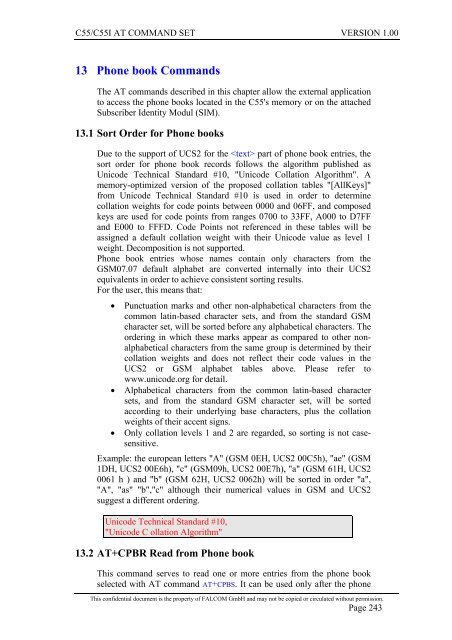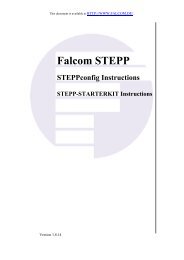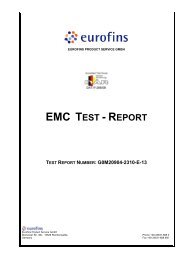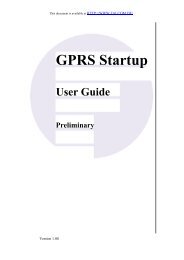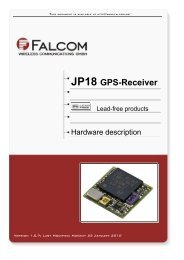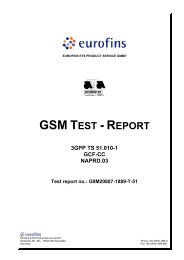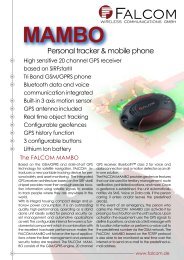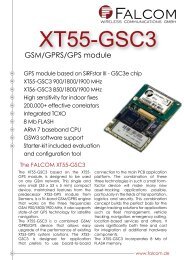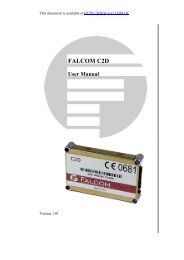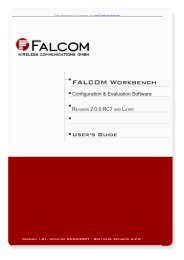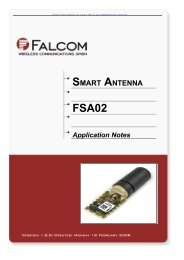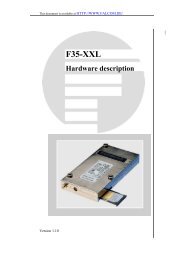C55/C55i AT COMMAND SET Description Preliminary - Falcom
C55/C55i AT COMMAND SET Description Preliminary - Falcom
C55/C55i AT COMMAND SET Description Preliminary - Falcom
You also want an ePaper? Increase the reach of your titles
YUMPU automatically turns print PDFs into web optimized ePapers that Google loves.
<strong>C55</strong>/<strong>C55</strong>I <strong>AT</strong> <strong>COMMAND</strong> <strong>SET</strong> VERSION 1.00<br />
13 Phone book Commands<br />
The <strong>AT</strong> commands described in this chapter allow the external application<br />
to access the phone books located in the <strong>C55</strong>'s memory or on the attached<br />
Subscriber Identity Modul (SIM).<br />
13.1 Sort Order for Phone books<br />
Due to the support of UCS2 for the part of phone book entries, the<br />
sort order for phone book records follows the algorithm published as<br />
Unicode Technical Standard #10, "Unicode Collation Algorithm". A<br />
memory-optimized version of the proposed collation tables "[AllKeys]"<br />
from Unicode Technical Standard #10 is used in order to determine<br />
collation weights for code points between 0000 and 06FF, and composed<br />
keys are used for code points from ranges 0700 to 33FF, A000 to D7FF<br />
and E000 to FFFD. Code Points not referenced in these tables will be<br />
assigned a default collation weight with their Unicode value as level 1<br />
weight. Decomposition is not supported.<br />
Phone book entries whose names contain only characters from the<br />
GSM07.07 default alphabet are converted internally into their UCS2<br />
equivalents in order to achieve consistent sorting results.<br />
For the user, this means that:<br />
• Punctuation marks and other non-alphabetical characters from the<br />
common latin-based character sets, and from the standard GSM<br />
character set, will be sorted before any alphabetical characters. The<br />
ordering in which these marks appear as compared to other nonalphabetical<br />
characters from the same group is determined by their<br />
collation weights and does not reflect their code values in the<br />
UCS2 or GSM alphabet tables above. Please refer to<br />
www.unicode.org for detail.<br />
• Alphabetical characters from the common latin-based character<br />
sets, and from the standard GSM character set, will be sorted<br />
according to their underlying base characters, plus the collation<br />
weights of their accent signs.<br />
• Only collation levels 1 and 2 are regarded, so sorting is not casesensitive.<br />
Example: the european letters "A" (GSM 0EH, UCS2 00C5h), "ae" (GSM<br />
1DH, UCS2 00E6h), "c" (GSM09h, UCS2 00E7h), "a" (GSM 61H, UCS2<br />
0061 h ) and "b" (GSM 62H, UCS2 0062h) will be sorted in order "a",<br />
"A", "as" "b","c" although their numerical values in GSM and UCS2<br />
suggest a different ordering.<br />
Unicode Technical Standard #10,<br />
"Unicode C ollation Algorithm"<br />
13.2 <strong>AT</strong>+CPBR Read from Phone book<br />
This command serves to read one or more entries from the phone book<br />
selected with <strong>AT</strong> command <strong>AT</strong>+CPBS. It can be used only after the phone<br />
This confidential document is the property of FALCOM GmbH and may not be copied or circulated without permission.<br />
Page 243


